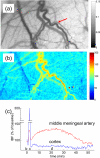Laser speckle contrast imaging in biomedical optics
- PMID: 20210435
- PMCID: PMC2816990
- DOI: 10.1117/1.3285504
Laser speckle contrast imaging in biomedical optics
Abstract
First introduced in the 1980s, laser speckle contrast imaging is a powerful tool for full-field imaging of blood flow. Recently laser speckle contrast imaging has gained increased attention, in part due to its rapid adoption for blood flow studies in the brain. We review the underlying physics of speckle contrast imaging and discuss recent developments to improve the quantitative accuracy of blood flow measures. We also review applications of laser speckle contrast imaging in neuroscience, dermatology and ophthalmology.
Figures







References
-
- Cummins H. and Swinney H. L., “Light beating spectroscopy,” in Progress in Optics, Wolf E., Ed., Vol. VIII, p. 133, North Holland Publishing Co., Amsterdam: (1970).
-
- Riva C., Ross B., and Benedek G. B., “Laser Doppler measurements of blood flow in capillary tubes and retinal arteries,” Invest. Ophthalmol. INOPAO 11, 936–944 (1972). - PubMed
-
- Berne P. J. and Pecora R., Dynamic Light Scattering, Wiley, New York: (1976).
Publication types
MeSH terms
Grants and funding
LinkOut - more resources
Full Text Sources
Other Literature Sources
Medical

